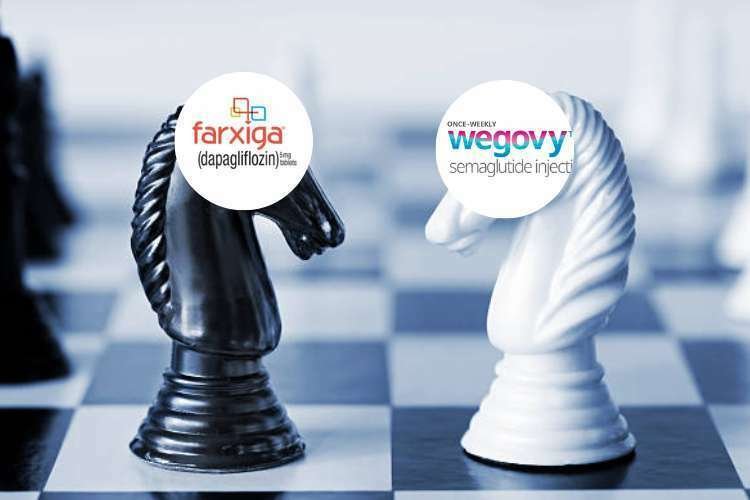Novo Nordisk’s semaglutide and AstraZeneca’s Farxiga assuming the roles of formidable contenders. The arena is no longer confined to blood sugar control; it now extends into the realm of heart health. As these two pharmaceutical titans stride forward, their strategies and successes are sparking conversations that ripple through medical corridors and boardrooms alike.
The European Society for Cardiology (ESC) congress served as a stage for Novo Nordisk’s revelation. With all the flair of a masterful performance, the company unveiled Wegovy – a once-weekly semaglutide at the potent 2.4-mg dosage. The grand reveal showcased Wegovy’s remarkable ability to alleviate symptoms of heart failure in select patients. It was a seismic moment that sent shockwaves of curiosity and contemplation through the medical community.
AstraZeneca, undeniably a key player in the biopharmaceutical realm, finds itself in an interesting position. Ruud Dobber, the company’s biopharma business president, radiates confidence in the face of this brewing competition. Dobber acknowledges the strategic importance of Farxiga’s role in heart failure management, which has driven its success thus far. Yet, he remains resolute – the rise of GLP-1 drugs, though noteworthy, is not a current threat to the dominance of the SGLT2 class.
The battleground in question is none other than the intricate world of heart failure. Here, Farxiga reigns supreme with its versatile label, transcending factors like ejection fraction status and body weight. Novo Nordisk’s Wegovy, however, hones its focus on obese patients with heart failure and preserved ejection fraction (HFpEF). A calculated move, considering that the majority of HFpEF patients are overweight or obese.
Yet, the narrative remains incomplete. While Wegovy’s STEP-HFpEF trial showcased promise, the crucial question of its impact on heart failure events and mortality lingers like an unsolved puzzle. This enigma, as revealed by the authors of a New England Journal of Medicine editorial, forms the very cornerstone that could determine the roles of GLP-1 agonists and SGLT2 inhibitors in heart failure treatment.
Obtaining cardiovascular outcome results of this nature typically necessitates a substantial trial conducted over an extended duration, as pointed out by Dobber. On a related note, AZ’s medication Farxiga received approval for treating heart failure based on findings from a phase 3 clinical trial involving 6,263 patients. The patent for Farxiga is expected to expire around 2028.
In a distinct study, Novo’s drug Wegovy demonstrated a 20% reduction in the risk of cardiovascular-related fatality, heart attack, or stroke in comparison to a placebo and the established standard of care. This trial engaged 17,604 participants who were overweight or obese and had a preexisting history of cardiovascular disease. The investigation spanned up to five years and encompassed individuals aged 45 and older. Notably, the subjects in this trial were afflicted with cardiovascular disease, excluding instances of heart failure.
Yet, within AstraZeneca’s fortress, echoes of competition reverberate. Eli Lilly and Boehringer Ingelheim’s Jardiance, a formidable contender from within the SGLT2 class, stands tall with its heart failure approval. The stage further widens as both Farxiga and Jardiance find themselves in the spotlight of Medicare price negotiations.
Beyond the SGLT2 class, Eli Lilly’s Mounjaro enters the stage as a dual GIP/GLP-1 agonist. Positioned as a rising star, it’s on the brink of approval not only for diabetes but also obesity, hinting at a future where multiple fronts could define the battle against these intertwined maladies.
As the dust of competition settles, one fact remains certain – Farxiga holds its own as the most utilized SGLT2 inhibitor worldwide. Yet, it trails Jardiance in the U.S., where its market share hovers between 30% and 35%. Interestingly, the spotlight cast on the GLP-1 class seems to have cast a halo over Lilly.
AstraZeneca, ever the innovator, is not one to remain idle. Their journey through the GLP-1 pathway has culminated in FDA-approved Bydureon. Despite this, they’ve recently shifted their focus to the developmental stages of the weekly GLP-1/glucagon candidate AZD9550, a calculated move that promises future excitement.
However, Farxiga remains their current focal point. The strategy dances on the edge of experimentation, with multiple Farxiga combinations in phase 2 development. Among these, the inclusion of baxdrostat, a result of a $1.8 billion acquisition, ignites anticipation as readouts are anticipated in late 2023 or early 2024.
Related: Farxiga/Forxiga: Drug For Diabetes, Heart Failure And Kidney Disease
Novo Nordisk’s Wegovy and AstraZeneca’s Farxiga lock horns not merely for diabetes treatment but for the very heartbeats of those they aim to heal. As the saga unfolds, the medical world watches with bated breath, eager to witness the next chapter in this unfolding tale of innovation and competition.





























